Source: Vernacular Blockchain
Recently, with the listing of Goat, Pnut, Act and other memes on Binance, the Solana ecosystem has ushered in a new wave of enthusiasm. According to statistics from Blockworks Research, after October 19, 2024, Solana's daily on-chain fees have exceeded Ethereum for many consecutive days, and on October 24, the revenue even exceeded 10 million US dollars. The popularity of the Meme track has allowed various funds to continue to enter the Solana ecosystem, making it the hottest ecosystem in the circle.
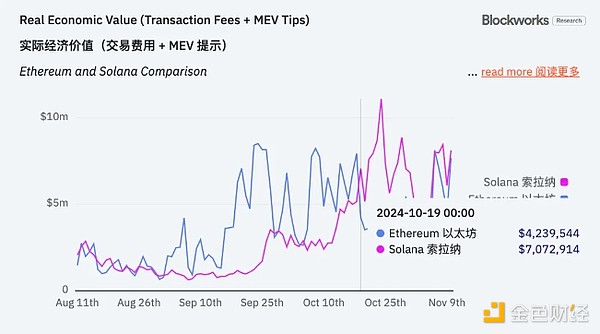
It has to be said that Solana is indeed the hottest chain in this round of bull market. More than half of the star projects in the DePin craze came from the Solana ecosystem, and there were waves of Meme crazes. It can be said that it is very lively.
So, where does the high income of the Solana ecosystem that we see now mainly come from? How long can such a hot state last?
Overview of Solana chain fees
Similar to Ethereum, Solana's on-chain income also includes basic transaction fees, MEV tips, etc. After the EIP1599 proposal, Ethereum destroyed all the basic Base fees, and the MEV tips were directly rewarded to the verification nodes. Solana also has a similar destruction mechanism, destroying the basic handling fees at a fixed ratio (50% was set initially), and the rest was distributed to the validators.
Therefore, when comparing the on-chain revenues of Ethereum and Solana, all destroyed basic transaction fees are also included.
Specifically, Solana's on-chain revenues include basic fees, limited transaction fees, tips (Jito), and voting fees, as shown in the figure below.

From the daily fee change trend on the Solana chain shown in this figure, compared with the other two items, the basic transaction fee and voting fee have not changed much, but the priority transaction fee and tip have grown rapidly since March this year.
So, what are these two fees? The priority transaction fee is easy to understand, that is, the fee paid by users to speed up transactions, which is generally added directly at the time of transaction. Tips (Jito) are additional fees paid by users to validators, generally used for MEV-related transactions and targeted payments.
The rapid growth of both means that the activity of the Solana network has increased, and the network congestion caused by the increase in DeFi activities has intensified. Users are more willing to increase transaction speed by increasing priority transaction fees, and at the same time, validators have more opportunities to capture MEV by optimizing transaction order.
So, what are the specific DeFi transactions on the Solana chain, and are they completely Meme-driven?
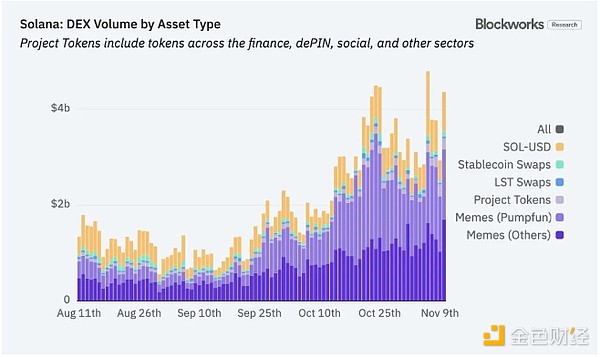
It is not difficult to see from the data in the above figure that the transactions on the Solana chain mainly include Meme (Pumpfun), Meme (others), project Tokens, LST Tokens, stablecoins and SOL transactions, among which project Tokens include DePin, SocialFi, etc. in addition to all the categories listed above.
In the past two months, the transaction volume of all Memes has increased from 48% to 74%. Of course, the sharp decline in the proportion of other transaction volumes does not mean a decrease in transaction volume. When the market is rising, the transaction volume of projects on the Solana chain, such as Token, LST, stablecoins, and SOL, has increased significantly. However, the increase in Meme is too exaggerated, with an increase of 667% in the past two months. Therefore, the proportion of other transactions has dropped significantly in comparison.
This also confirms the above data. Due to the rapid growth of Meme transaction volume and the belief that "time is money" in Meme transactions, users are naturally more willing to pay priority transaction fees. The more active the on-chain transactions, the more opportunities there are for MEV.
Active Dapps on Solana Chain
1) DEX
Currently, Meme transactions are the main form of transactions on Solana chain, so naturally, DEX is the most active Dapp. Among all the DEXs in Solana ecosystem, Raydium is the most popular one. The data in the figure below shows that, thanks to the outbreak of Meme, Raydium, which is deeply bound to Meme, has occupied 63.5% of the transaction volume of the entire Solana ecosystem. Orca, which occupied an absolute advantage in Solana ecosystem at the beginning, has been squeezed with the outbreak of Meme transaction volume, and its market share has been continuously squeezed, from more than 60% to the current 15%.
PumpFun, as a Meme launch platform, has its own Meme transaction function, which also accounts for nearly 5% of the transaction volume in this wave of Meme outbreak, and there is a trend of gradual increase.
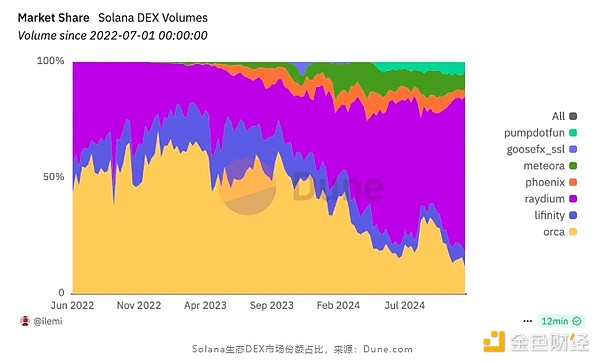
2) Aggregate DEX and trading robots
In addition to direct transactions on DEX, aggregated DEX and trading robots in the Solana ecosystem are also very active. The figure below shows the market share of Solana ecosystem DEX by transaction source. The latest data shows that Jupiter's transaction volume accounts for 33%, and other protocols (including trading robots) account for 19%.
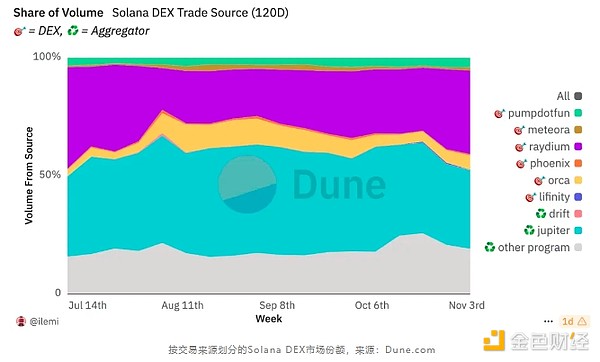
As the largest aggregated trading Dex in the Solana ecosystem, Jupiter’s current TVL has exceeded 1.57 billion US dollars, setting a new high, and Jupiter has been very active recently:
First, on October 2, the proposal to "use the unclaimed 230 million JUP to extend and fund ASR" was passed, and the active equity staking reward (ASR) will be extended for another year;
Then on October 8, a mobile application was launched to support Apple Pay, credit cards and other payment methods are considered to be a new legal-to-B channel;
On October 17, the Solana MemeCoin terminal "Ape Pro" was launched, focusing on achieving MEV protection and improving the sandwich attack phenomenon in transactions. Under a series of actions, the price of Token JUP is also very strong.
In addition to the aggregated trading platform, the trading robots in the Solana ecosystem are also very active. More than 10% of the transactions are contributed by trading robots, among which the top four in terms of revenue are Photon, Trojan, BONKbot and Banana Gun. Photon's revenue in the past thirty days reached 29.85 million US dollars, making it the protocol in the Solana ecosystem second only to the Solana main chain in terms of revenue. In addition to the Solana main chain and the Pump protocol, the other three seats in the top five protocols of Solana's ecological revenue are all trading robots, and their ability to attract money is evident.
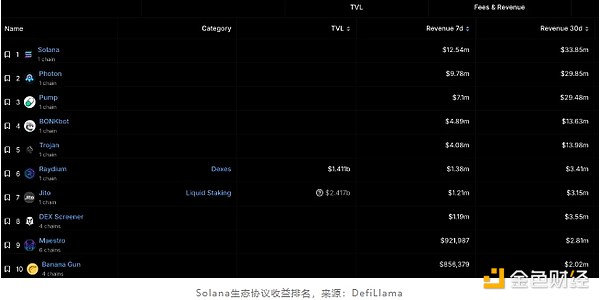
3) Other Dapps
Although DEX, aggregated DEX and trading robots around Meme were very popular throughout the Meme season, with the popularity of the Solana chain, the price of SOL has also risen all the way, thereby driving the pledge, re-pledge, borrowing, leverage and other protocols in the ecosystem. The following are several of the more popular Dapps.
Jito is currently the DApp with the highest TVL in the Solana ecosystem, with a TVL of more than $3 billion, accounting for more than one-third of the TVL of the entire Solana ecosystem.
Jito supports users to deposit Solana or Solana's LST Token for re-staking. Compared with other staking protocols, Jito's biggest feature is its MEV suite, which extracts MEV income from transactions in the Solana ecosystem and distributes this part of the income to the pledgers, thereby increasing the income of the pledgers.
Currently, Jito's re-staking deposits have reached a hard cap of $25 million, indicating that the upper limit will be increased in the second phase to meet the staking needs of more users.
Kamino is the top stablecoin and LST asset income platform in the Solana ecosystem. It also integrates functions such as lending, liquidity provision and leverage. The TVL of the entire protocol has reached 2 billion US dollars.
Kamino supports a one-click automatic compounding centralized liquidity strategy, which allows users to maximize returns by controlling borrowed funds. In addition, Lend V2 is expected to be launched in the fourth quarter of this year, which will allow the permissionless creation of different borrowing markets to meet the needs of a wider range of users, as well as the introduction of automated single-asset borrowing vaults to aggregate liquidity across markets, in order to become the foundation layer of Solana's on-chain finance.
Marinade is also a liquidity staking protocol for the Solana ecosystem. Its current TVL is 1.79 billion, ranking fifth after Raydium. However, as a liquidity staking protocol, the revenue of the Marinade protocol is far less than that of Jito. Recently, Marinade has been promoting Solana staking services for institutional investors. Its TVL has risen by nearly 50% in the past month and a half.
Summary
The Meme craze has indeed driven the popularity of the entire Solana ecosystem. The most direct manifestation is Solana's on-chain revenue and user activity.
However, the current Meme is only a product of a specific period in the bull market. Once the bear market enters, if the MeMe market no longer continues, how the Solana ecosystem can maintain its leading edge in the public chain is something that needs to be considered. Just like the NFT market that was once popular, it was a mess after the feast. Can Solana take advantage of the popularity of MeMe to create a healthier ecological income structure?
 Joy
Joy










